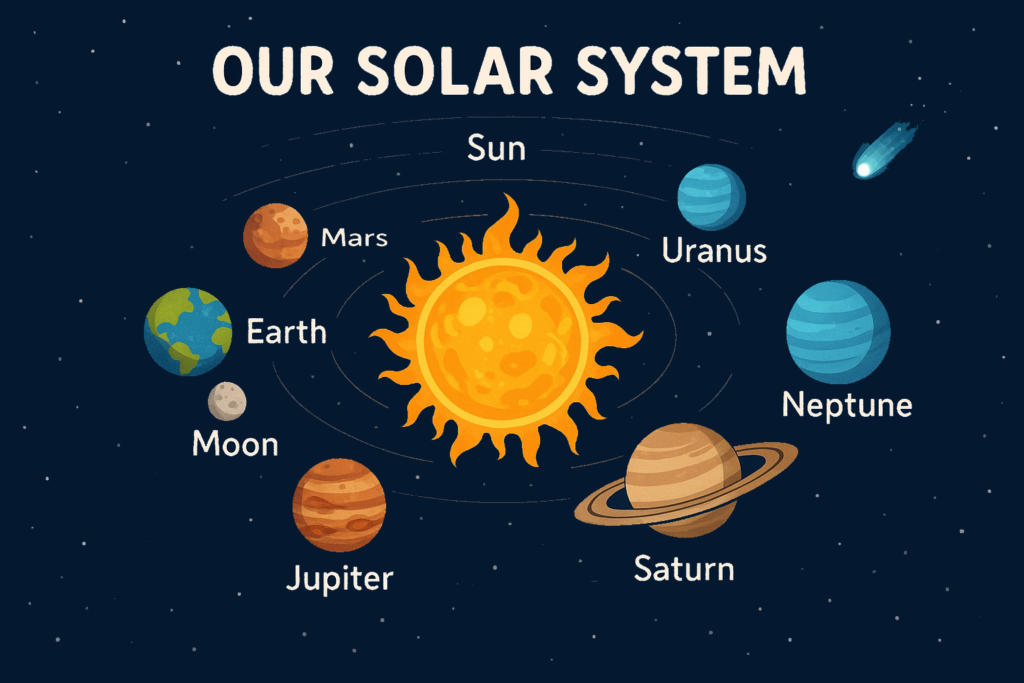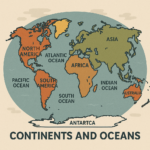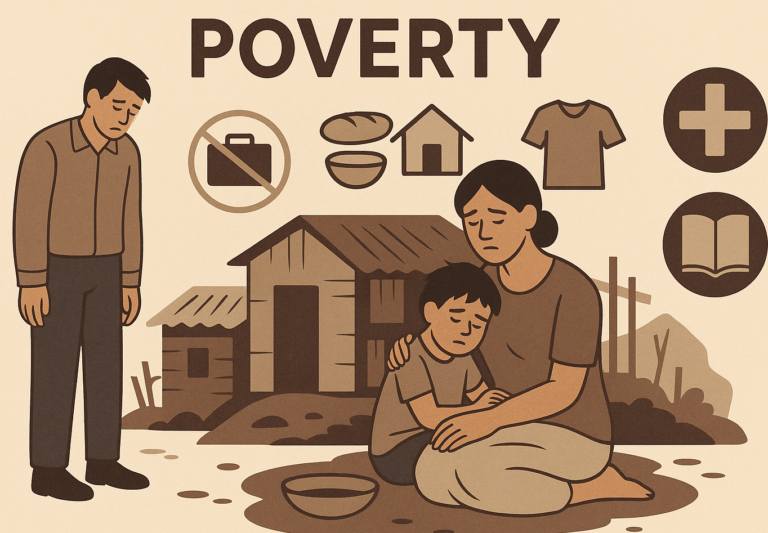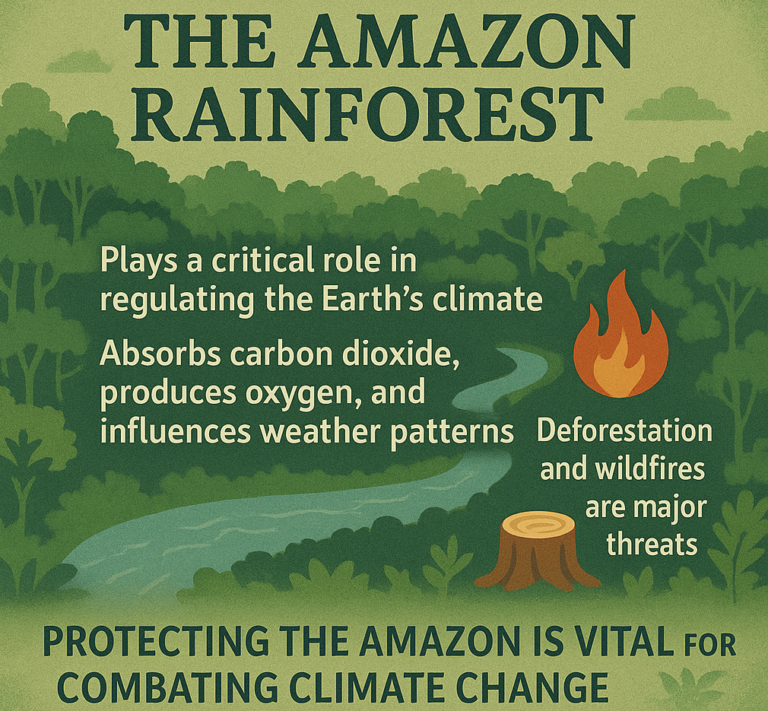The Water Cycle: What It Is and Why It’s Important
The water cycle, also known as the hydrological cycle, is the continuous movement of water within the Earth and atmosphere. It describes how water circulates through different parts of our environment—oceans, rivers, lakes, clouds, and land—moving in a cycle that doesn’t stop.
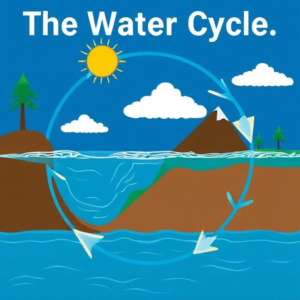
Steps of the Water Cycle
There are four main stages in the water cycle:
- Evaporation
- Condensation
- Precipitation
- Collection
1. Evaporation (Turning Water into Vapor)
- What happens: The cycle starts when the sun’s heat warms up water in rivers, lakes, and oceans. This heat causes water to turn into water vapor (a gas) and rise into the air. This process is called evaporation.
- Where it happens: Mainly from bodies of water like oceans, lakes, and rivers, but it also happens from plants (through a process called transpiration, when plants release water vapor through their leaves).
- Why it’s important: Evaporation is the first step in moving water from the Earth’s surface into the atmosphere, starting the cycle.
2. Condensation (Water Vapor Forms Clouds)
- What happens: As water vapor rises higher into the air, it cools down and condenses (changes back into tiny droplets of water) to form clouds. This is because cooler air can hold less water vapor than warm air.
- Where it happens: In the upper part of the atmosphere, where the air is cooler.
- Why it’s important: Condensation is the process that creates clouds, which are the storage vessels for water before it falls back to the Earth as precipitation.
3. Precipitation (Water Falls from the Sky)
- What happens: When the clouds get too heavy with water droplets, they release the water as precipitation—this can be rain, snow, hail, or sleet, depending on the temperature and weather conditions.
- Where it happens: It happens in the atmosphere, when clouds reach their full capacity and can no longer hold the water.
- Why it’s important: Precipitation returns water back to the Earth’s surface, replenishing freshwater sources like rivers, lakes, and groundwater. It is essential for maintaining life and ecosystems.
4. Collection (Water Returns to Earth)
- What happens: Once the precipitation reaches the Earth, it travels across the ground in rivers and streams, which carry the water back to oceans, lakes, or underground aquifers (called groundwater).
- Where it happens: On the Earth’s surface, water either flows into rivers or seeps into the soil.
- Why it’s important: Collection ensures that water is returned to the surface and either stored in bodies of water or filtered into the ground to be used again. It completes the cycle, and the process starts over.
Why Is the Water Cycle Important?
The water cycle is a vital process for all life on Earth. Here’s why it’s so crucial:
1. Freshwater Supply
- Renewable Water Source: The water cycle ensures that water is constantly being replenished. While the Earth’s total amount of water remains the same, the water cycle makes sure that it is constantly moving and renewing—especially through precipitation and collection—so that we have water in lakes, rivers, and groundwater for drinking, irrigation, and industrial use.
2. Climate Regulation
- Temperature Control: The water cycle helps regulate temperatures by moving heat through the atmosphere. Evaporation cools the Earth, while condensation releases heat, which helps maintain the Earth’s balance.
- Rain and Snow: Precipitation directly affects the climate and weather patterns. Without the water cycle, we wouldn’t have regular rainfall to support agriculture or snow to build glaciers.
3. Support for Ecosystems
- Plant Growth: Water is essential for plants to grow. The water cycle provides plants with the water they need through precipitation (rain) and groundwater, allowing them to thrive in ecosystems like forests, grasslands, and wetlands.
- Animal Habitats: Animals depend on fresh water from rivers, lakes, and streams, which are replenished by the water cycle. Without a healthy cycle, wildlife would not have access to water sources.
4. Flood and Drought Prevention
- Flood Control: The cycle helps regulate water distribution. If too much water accumulates in the atmosphere, it can lead to heavy precipitation, causing floods. On the other hand, too little precipitation can lead to droughts.
- Groundwater Recharge: When water infiltrates the ground during precipitation, it replenishes underground aquifers, providing a stable and long-term water source during dry periods.
5. Hydroelectric Power Generation
- Energy Source: Moving water is used in hydroelectric dams to generate electricity. The water cycle helps ensure a continuous flow of water through rivers, which is vital for power plants that rely on water movement to generate energy.
Human Impact on the Water Cycle
Human activities can affect the water cycle in several ways:
- Deforestation: Cutting down trees reduces transpiration, meaning less water vapor is released into the atmosphere, which can lead to less rainfall.
- Urbanization: Cities with lots of concrete and asphalt prevent water from soaking into the ground, increasing surface runoff and reducing the amount of water that goes back into the soil.
- Climate Change: Human-caused global warming is altering weather patterns, leading to more intense storms, droughts, and changes in precipitation levels.
- Pollution: Water pollution can contaminate rivers and lakes, making it harder for humans and wildlife to access clean water.
Summary
The water cycle is the continuous movement of water on, above, and below the Earth’s surface. It has four main stages: evaporation, condensation, precipitation, and collection. This cycle is essential for providing fresh water, regulating the climate, supporting ecosystems, and even generating power.
By understanding and protecting the water cycle, we can ensure a sustainable water supply for the future and maintain the balance of our environment.


